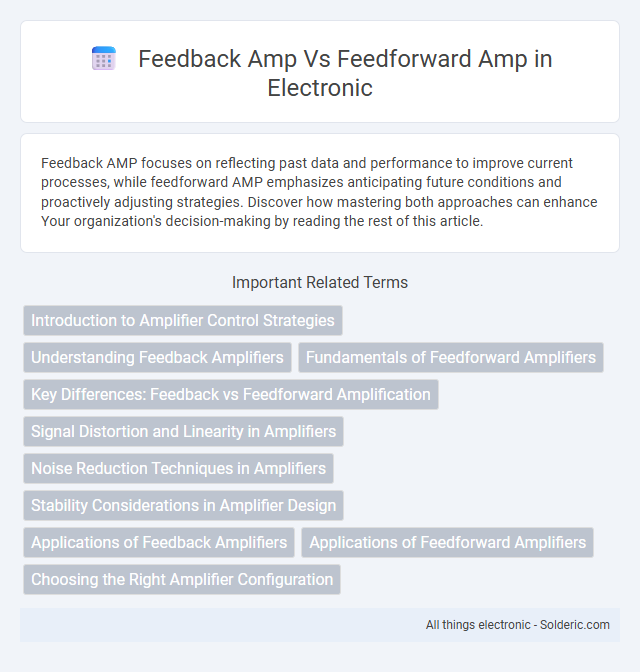Feedback AMP focuses on reflecting past data and performance to improve current processes, while feedforward AMP emphasizes anticipating future conditions and proactively adjusting strategies. Discover how mastering both approaches can enhance Your organization's decision-making by reading the rest of this article.
Comparison Table
| Aspect | Feedback Amplifier | Feedforward Amplifier |
|---|---|---|
| Definition | Uses output signal feedback to input for error correction | Uses a separate path to cancel distortion or errors in output |
| Operation | Negative feedback loop reduces gain and distortion | Distortion is detected and subtracted before output |
| Distortion Reduction | Reduces distortion by feedback control | More effective distortion cancellation via feedforward path |
| Gain Impact | Gain is reduced due to feedback | High gain maintained, minimal effect on gain |
| Stability | Can face stability issues if feedback loop is not designed properly | Generally stable as feedback loop is absent |
| Complexity | Relatively simpler implementation | More complex design and circuitry required |
| Application | Common in audio, control systems, and linear amplifiers | Used in high-fidelity and precision amplifier designs |
Introduction to Amplifier Control Strategies
Feedback amplifiers utilize output signal feedback to stabilize gain and reduce distortion, enhancing accuracy in signal processing. Feedforward amplifiers improve linearity by detecting and canceling distortion before it reaches the output, leading to superior performance in high-fidelity applications. Both strategies play crucial roles in optimizing amplifier behavior for various electronic systems.
Understanding Feedback Amplifiers
Feedback amplifiers use a portion of the output signal fed back to the input to stabilize gain, reduce distortion, and improve bandwidth. Understanding feedback amplifiers involves analyzing how negative feedback controls the amplifier's overall gain and enhances linearity, making your audio or signal processing more reliable. Precise control of feedback factors ensures optimized performance in applications such as audio systems, instrumentation, and communication devices.
Fundamentals of Feedforward Amplifiers
Feedforward amplifiers utilize a portion of the input signal to correct distortion generated by the main amplifier, significantly improving linearity and reducing harmonic distortion. The fundamental principle involves sampling the error signal created by the main amplifier and feeding it forward in phase opposition to cancel out the distortion. Your audio or communication system benefits from enhanced signal fidelity and efficiency by incorporating these principles.
Key Differences: Feedback vs Feedforward Amplification
Feedback amplification uses a portion of the output signal fed back to the input to stabilize and control gain, enhancing linearity and reducing distortion. Feedforward amplification, in contrast, processes an error signal derived from the difference between the input and a reference to correct output errors before amplification, improving accuracy and bandwidth. Your choice between feedback and feedforward amps depends on application needs such as stability, error correction, and frequency response.
Signal Distortion and Linearity in Amplifiers
Feedback amplifiers typically reduce signal distortion by correcting nonlinearities through negative feedback loops, enhancing overall linearity and fidelity. Feedforward amplifiers improve linearity by isolating and subtracting distortion components from the output, offering superior distortion cancellation without the loop gain limitations found in feedback designs. Your choice between the two depends on the required distortion performance and linearity, where feedforward amps excel in high-fidelity applications demanding minimal distortion.
Noise Reduction Techniques in Amplifiers
Feedback amplifiers reduce noise by using negative feedback to lower distortion and stabilize gain, resulting in improved signal clarity. Feedforward amplifiers enhance noise reduction by isolating and canceling distortion components before amplification, maintaining a high-fidelity output. Your choice between the two depends on the specific noise performance and linearity requirements of your amplifier design.
Stability Considerations in Amplifier Design
Feedback amplifiers enhance stability by reducing gain and bandwidth variations, making them less sensitive to component tolerances and temperature changes. Feedforward amplifiers improve stability by actively canceling distortion and error signals, thus maintaining linearity without sacrificing bandwidth. Your choice between these methods depends on the specific stability requirements and performance trade-offs in amplifier design.
Applications of Feedback Amplifiers
Feedback amplifiers are widely used in audio amplification systems, instrumentation, and control systems due to their superior stability, linearity, and reduced distortion. These amplifiers enhance gain accuracy and bandwidth, making them ideal for precision signal processing and measurement applications. Their inherent ability to minimize noise and distortion improves overall system performance in communication and audio devices.
Applications of Feedforward Amplifiers
Feedforward amplifiers excel in high-precision applications requiring ultra-low distortion and noise, such as audio equipment, RF transmitters, and instrumentation systems. Your signal maintains integrity through error correction mechanisms that actively cancel distortion by comparing input and output signals. This approach is vital in communication systems where linearity and signal fidelity are paramount.
Choosing the Right Amplifier Configuration
Selecting the right amplifier configuration depends on the specific application requirements; feedback amplifiers offer improved stability, linearity, and reduced distortion due to negative feedback loops, making them ideal for precision signal processing. Feedforward amplifiers excel in minimizing distortion and enhancing bandwidth by correcting output errors upfront, suitable for high-frequency and high-power applications. Evaluating factors such as gain accuracy, noise performance, bandwidth, and circuit complexity guides the choice between feedback and feedforward amplifier designs.
feedback amp vs feedforward amp Infographic

 solderic.com
solderic.com